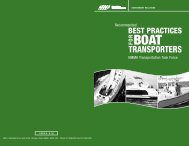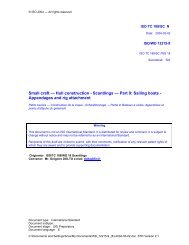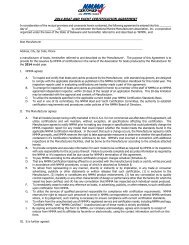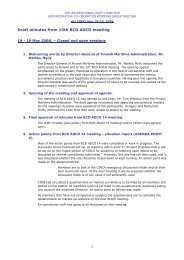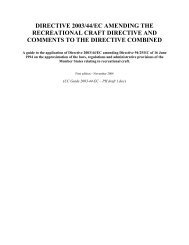global environmental legislation guide - National Marine ...
global environmental legislation guide - National Marine ...
global environmental legislation guide - National Marine ...
You also want an ePaper? Increase the reach of your titles
YUMPU automatically turns print PDFs into web optimized ePapers that Google loves.
The 4,000 participants attending the eighth meeting of the conference of the parties, held inMarch 2006, agreed to finalise negotiations as soon as possible and no later than 2010.A total of 600 delegates from governments, civil society and indigenous and localcommunities met from 10 to 16 July 2010 to come to agreement on the final version of thetext.ECIn 2001, the EU set the target to halt biodiversity loss in the EU by 2010. In 2002, it signed upto a <strong>global</strong> target of significantly reducing biodiversity loss worldwide by 2010.Efforts to tackle biodiversity loss were subsequently stepped up, and an EU BiodiversityAction Plan (BAP) was adopted by the Commission in 2006 to accelerate progress.Despite the efforts to date, however, there are clear indications that the EU will not achieveits target. At its March 2009 meeting on the environment, the council called for a new EUvision and target for biodiversity. Built on a <strong>global</strong> vision for biodiversity beyond 2010, it is apart of an updated strategic plan to implement the United Nations convention on biologicaldiversity. The plan was supposed to be adopted by the end of 2010 however due to delays itwas not approved until July 2011.Issues for the recreational marine and superyacht industries• Control and management of ships' bio fouling to minimize the transfer of invasiveaquatic species (will be regulated by the IMO convention)• Control and management of ships' ballast water and sediment (will be regulated bythe IMO convention)• Pollution by emissions (see IMO regulations)• Unsustainable practices (design, use, service and production processes)VI. International regulation of styreneInternational regulations of styrene can be divided into two important areas:A. Exposures to human bodiesB. Emissions to the environmentA. Exposure to human bodies:The following policy developments set on <strong>global</strong> basis the limits for styrene exposure levelsat the production facilities of GRP/FRP boats/yachts;• The International Agency for Research on Cancer (IARC) in Lyon, France, upgradedstyrene's classification from a Group 3 (not classifiable) to a Group 2B (possiblycarcinogenic to humans). This reclassification resulted from revisions to IARC'sclassification scheme and considerations of styrene oxide, an intermediate formedduring styrene metabolism. It is important to note that IARC specifically states that itsclassifications are intended for hazard identification only.39



